WILL FERREIRA DYKE chats to MA Slade Graduate PAULA TURMINA about her installation at the Slade Graduate show 2021. Her final piece, which confronts themes of colonialism, scientific discovery, and the climate crisis, was created from the natural pigments of a singular rock brought back from Brazil.
Hello Paula, how have you been?
Good, thank you. I have been in Poland for a month, so have been out of the studio and away from this crazy graduation high. It has been nice to get away for a little bit. I am currently focussing on the writing side of my practice, and planning for the next paintings and shows.
Am I right in thinking that you’ve just graduated from the MA Fine Art painting pathway?
Indeed. The MA has a twenty-four-month teaching period whereas the MFA has eighteen. I have finished the practical section, but I still have to finalise the writing. The reason why it’s a little longer is that we have to do more academic writing, other than that it’s pretty much the same thing. My deadline is soon approaching at the end of this month. Wish me luck!
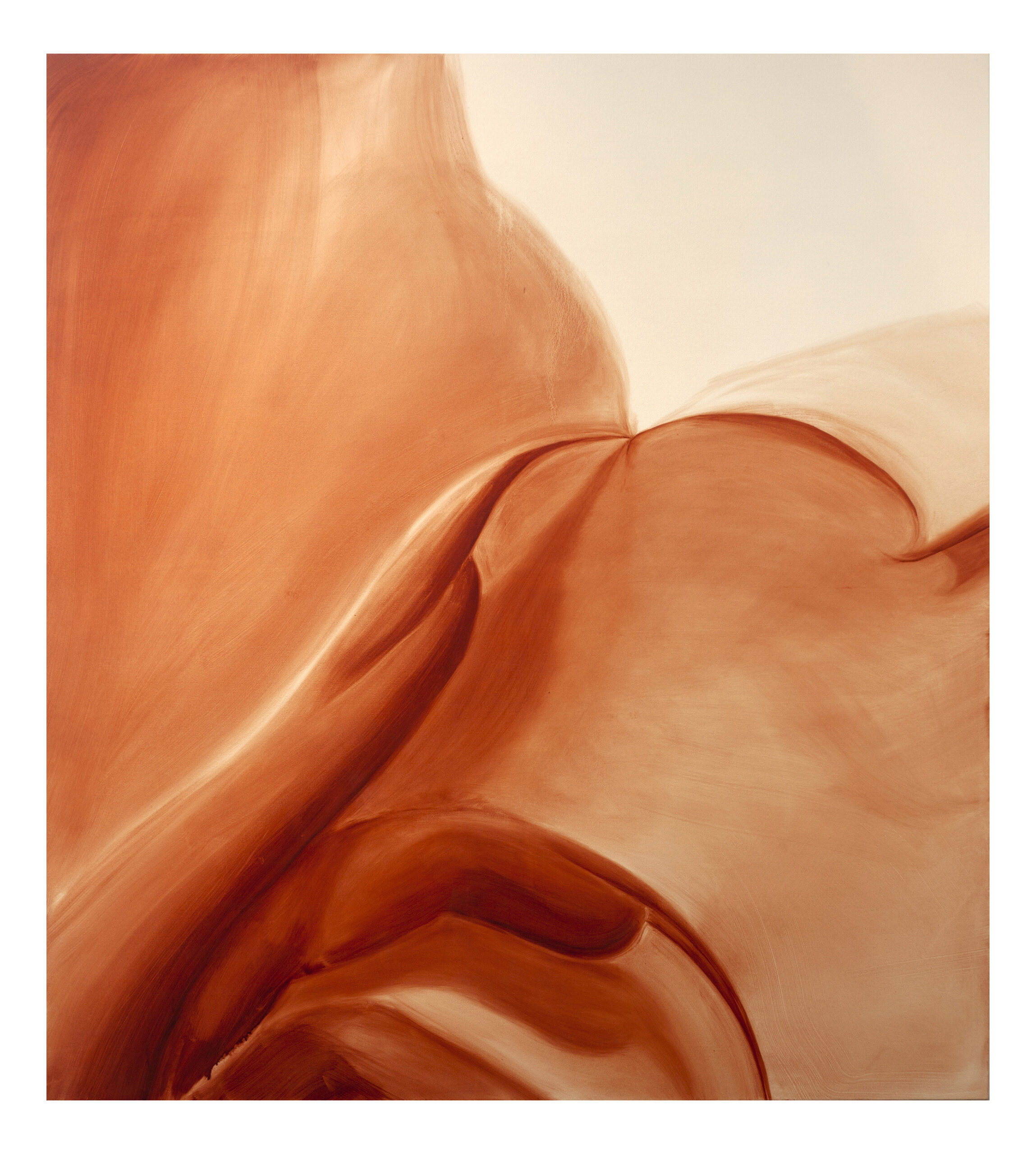
As you embark on your final few weeks at Slade, can you reflect on your time there? Did you do your BA there?
No, I did my BA at Wimbledon College of Arts and graduated in 2016. I then joined Slade for the post-grad in 2018. Slade has been insane! Especially the first year, which was pre-pandemic. The first year gave me everything: the people, the space, the tutors, the conversations which were going on – truly amazing! It was completely different – now obviously everything has changed, so I have slightly mixed feelings.
How did it compare to Wimbledon? Were there any obvious differences?
I think it’s hard to compare, because it’s not just the school but the stage at which I am at with my work. When I went to Wimbledon I had come straight from Brazil, my English wasn’t so good and I had the challenge of adapting to a completely new country. The course at Wimbledon gave me a calmer energy. The campus was situated in a quieter, loving, almost provincial, community. The Slade, on the other hand, centred in central London, had a greater focus on the art market, and where we should place ourselves within the context of Contemporary Art. Wimbledon was more about our practice and experimentation. I guess in some ways Slade had more pressure and competition, but perhaps that was because it was an MA and not a BA. However, both are brilliant schools for painting! I couldn’t think of better places to be for my practice.

That makes sense. Unfortunately, I didn’t get to go to the final show, but could you please describe your installation?
During the pandemic I interrupted my studies. I had this year out thinking I would have loads of time to prepare and make an incredible amount of work – but of course it didn’t end up like that. I ended up doing my degree show in the last three months before installation. It felt a little rushed, but in the end I was very pleased with the outcome. My idea stemmed from a stone I brought back from Brazil. I used the stone’s natural pigment as paint and created a body of work from it. It’s not something I do a lot, so I felt like I was taking a step, not necessarily forward, but a step nonetheless, by exploring something new in my practice. I was quite nervous at the start, as before this project I would use a lot of colour, so this reduction was definitely a challenge. However, it felt really good. Really needed. This tonal restriction allowed me to concentrate on one solid thought which I then pushed to communicate as best I could.
Your work was literally grounded in this rock, utilising its natural pigment, was this also showcased?
Yeah! I created a sculpture which held the stone. By the end it wasn’t a huge piece of rock, but to begin with it was fairly sizable. I also showed two big paintings and five smaller pieces, but I have loads of sketches and other paintings in the studio as well which were made from the stone.
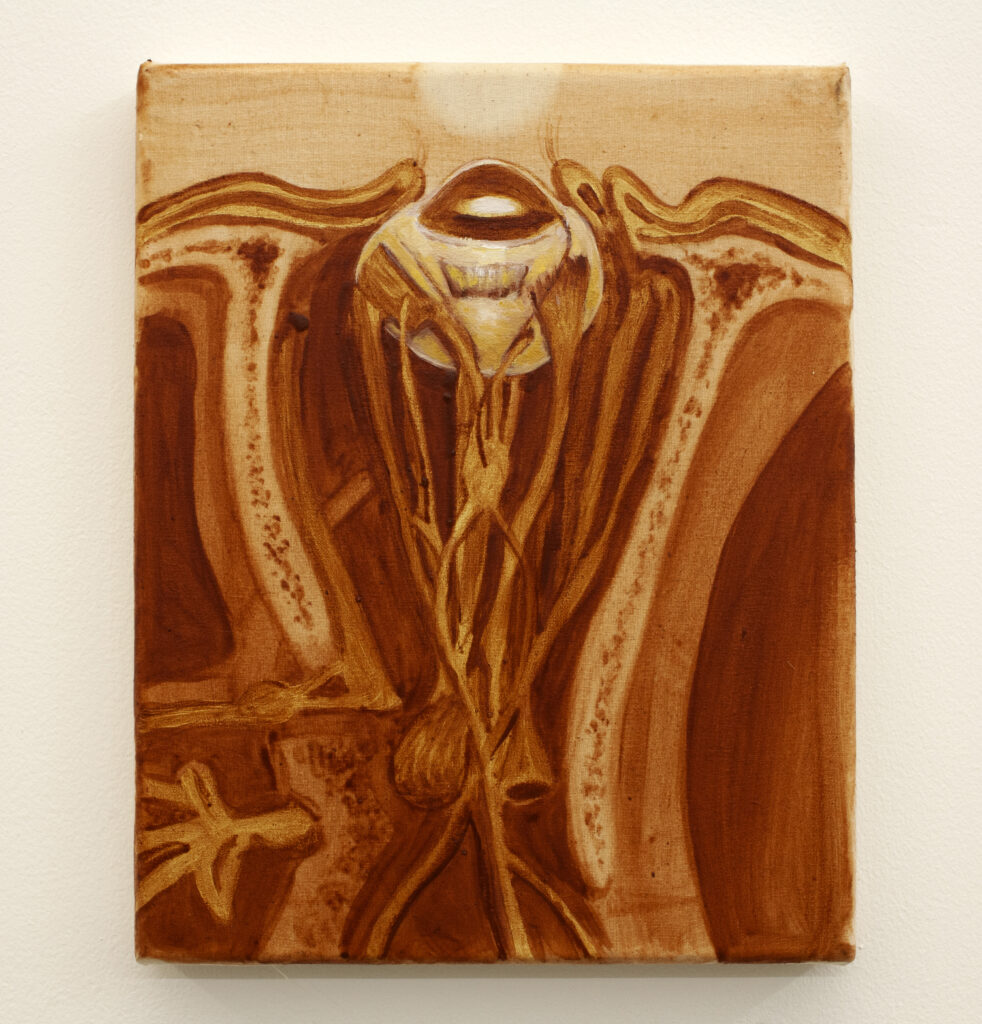
Your work explores notions of time and storytelling from a sci-fi perspective. What do you think initially drew you to this supernatural outlook?
I am very interested in how colonial activities alter landscapes, but I find it very difficult to tackle hard facts or reality. I don’t think these avenues necessarily allow for an expanded vision, whereas sci-fi always gives me a sense of beyond. Science fiction allows for you to enter something through a different perspective, one which is removed from reality to the point of great freedom; it is here that I find inspiration. I try to bring that to my work, which often resembles something real but always with a twist. These twists occur quite naturally. I don’t have a linear story, it comes rather visually.
Could you talk more about your interest in the rock, why were you drawn to this pigment?
My interest in this pigment is tied to Brazilian history, linking to the story of the Brazilwood tree that produces a red dye. This dye was thoroughly exploited in the 16th century, and ended up giving a name to the country. My interests also resideon a philosophical level, thinking about the use of resources, and about different perspectives on humanity, which I merge with my surreal ideas and fictions. I like combining the two, and I think painting is a perfect medium for that. Painting is inextricably bound to the physical, and I wanted to highlight this in my work. Having this grounding, a material centrality, allowed my supernatural subject matter great freedom because I knew it would always be brought back to earth. I like to remind the viewer that even though one may dream and expansively imagine other worlds, we are still made of an earthly material.
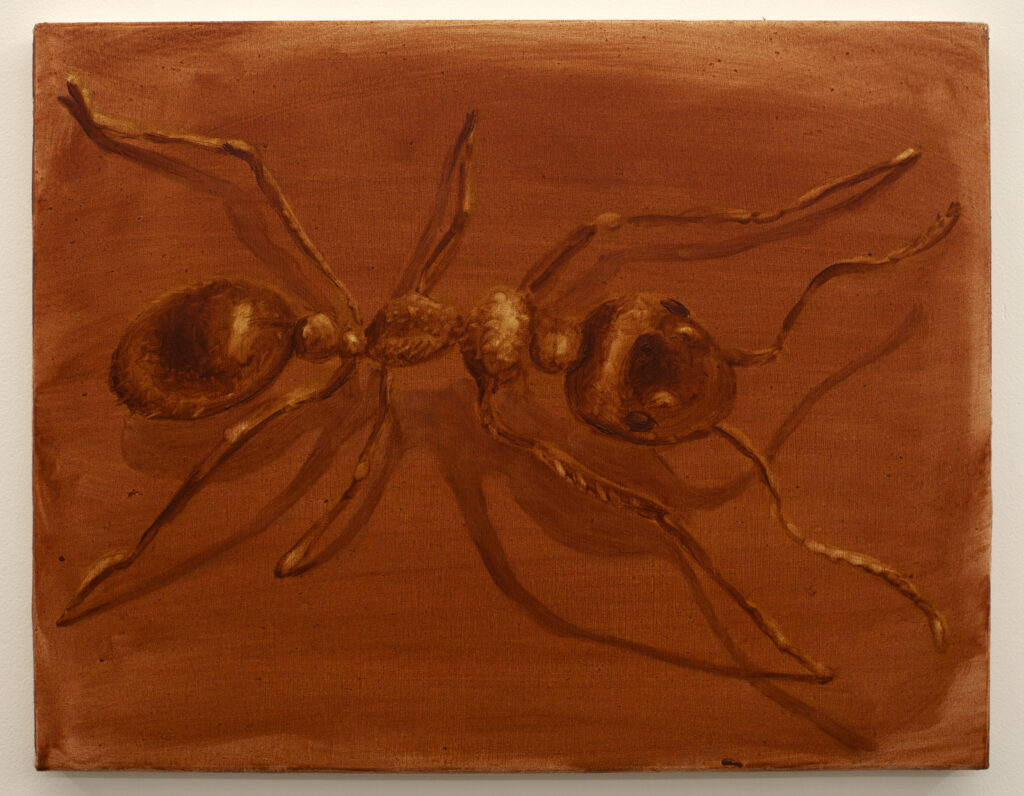
Your practice is also concerned with the relationship between the body and the landscape. What do you hope to do with this dialogue?
Good question, I’m still figuring it out. I think writing has helped a lot with thinking through ideas. I don’t want the paintings to say everything, and indeed they can’t say everything. I want my paintings to be able to tell multiple stories rather than something singular. I really like the idea of bodies somehow being in connection to the land. I don’t really feel like I am referencing a specific body. A lot of the time I will take references from my body, but I don’t consider this to be a self-portrait. I take myself as an inspiration for something I am speculating or imaging in my head. I also like to think of different species and how these affect our body: there is a morphing of bodies with more animalistic or botanical characteristics in my work, which anthropomorphises the human and challenges our human centred system.
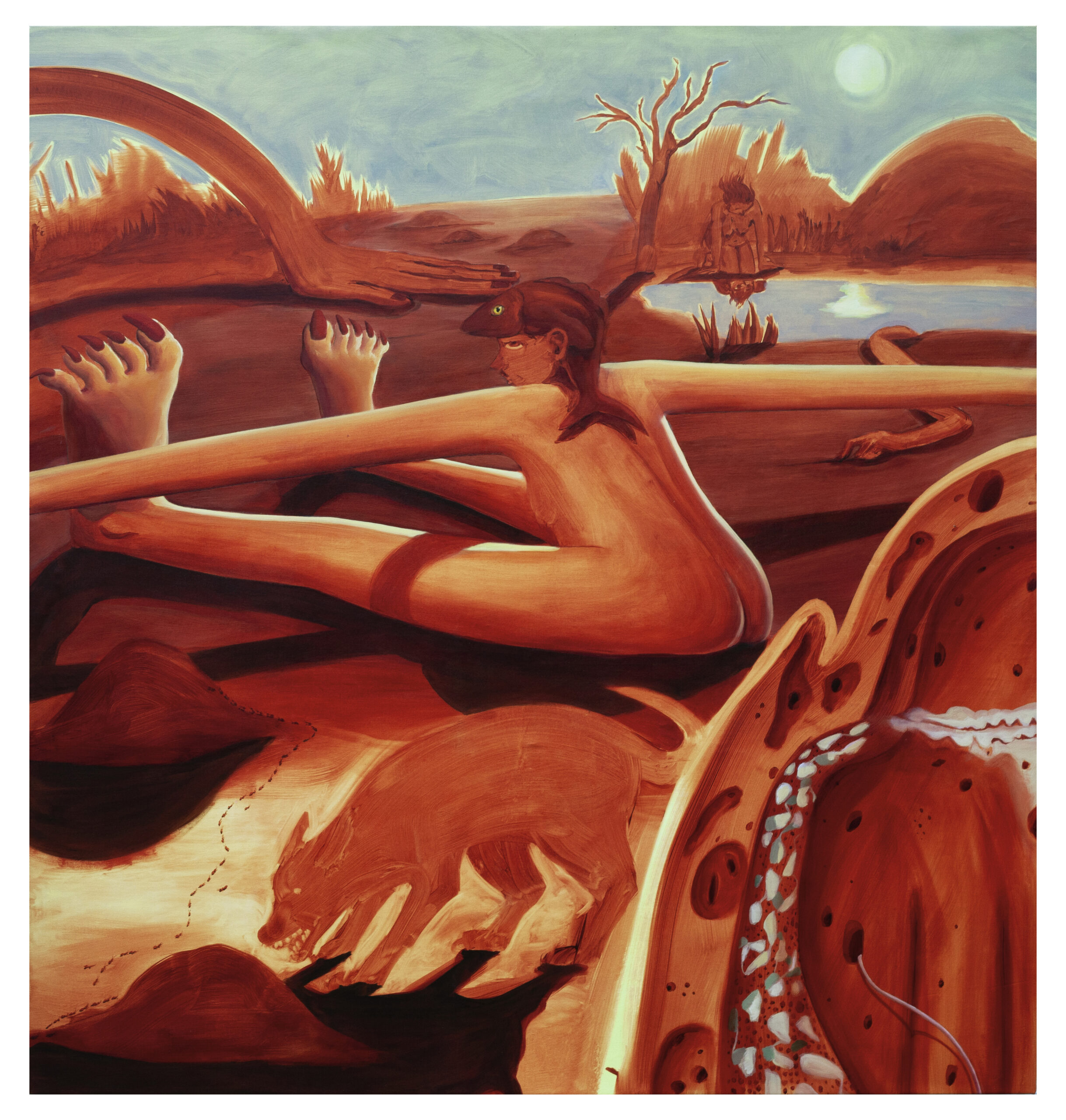
I particularly like your works Hot House and We are Not Going to Mars. Can you talk to me about these and your interest in Mars?
Both Hot House and We are Not Going to Mars have a similar composition and mirror each other in subject matter. The relationship between Mars and the Earth is what I’m writing about now in my thesis. The idea of escapism, the human need for frontiers, a salvation from worldly issues and the desire to go elsewhere run through both pieces. I am interested in these themes as they are very colonial, and my work is a tool to explore a way out of these ideologies. It is not necessarily about leaving our planet, as you can dream about these distant lands. Even if one were to go to Mars, you can never fully disconnect from earth, for our bodies always remain in dialogue with the ground. This is where the stone comes into my work again. The rock simultaneously helps to ground my work to Earth, whilst paradoxically alluding to the otherness of Mars and its terrain. I find these ideas fascinating. For example in We Are Not Going to Mars, the red landscape somewhat resembles Mars but this could also be read as Earth as a result of climate change.
Wow. It sounds as if you are grappling with major themes; colonial endeavours, scientific exploration as well as the climate crisis. How did you become interested in these topics? Can you take me through the process of a piece of work from start to finish?
I would say that my main visual inspiration is Sci-Fi: Octavia Butler, Kim Stanley Robinson, and Ursula Le Guin. I also look to Indigenous leaders from Brazil such as Ailton Krenak and Davi Kopenawa. Obviously, I must look at academic theory to be able to articulate my thoughts. A lot of people find it difficult to place my work in the context of visual referencing under the canon of History of Art. I think the closest I can get to an art historical moment is surrealism. I love surrealist visuals. Not so much their ideas because, well, lots were sexist. But I still enjoy the images. Remedios Varos is probably my main surrealist inspiration. She explores machinery, and really thinks about the physics and the textural materiality of her subjects. This scientific explanation allows for you to travel in her paintings.
I usually start with an idea or a material in mind, prepare the ground, the pigment or paint, and let the story emerge from an intuitive process of painting. I came to realise that key words are enough for me to kick things off, and I enjoy the reflection on what has emerged from this gesture afterwards.
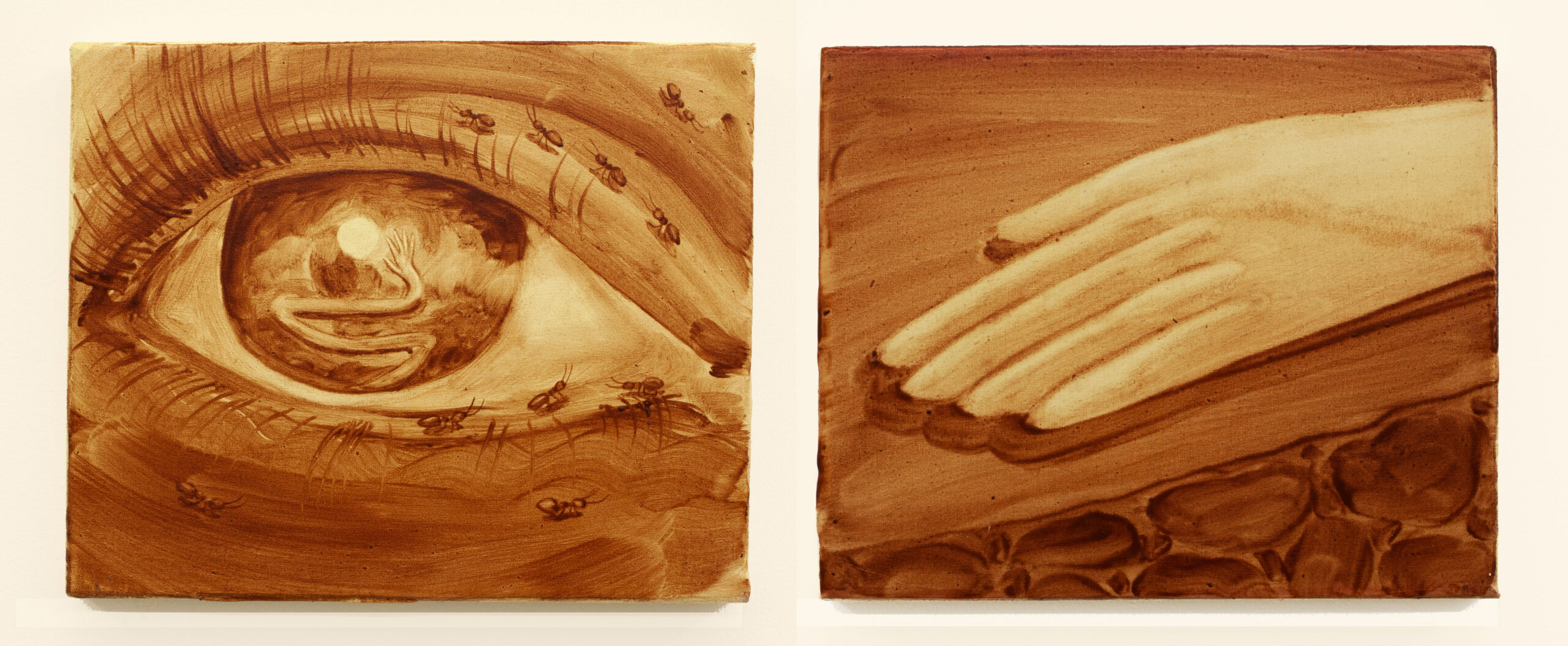
I can understand how you are drawn to this scientific explanation and can see parallels in your work. What are you working on at the moment?
I haven’t done much practical work recently, but my head is in a trans-novella that my friend Fer Boyd is writing – I’m going to introduce visuals into this book. They’re writing about this living being who comes from a red sinkhole and goes on a journey to change their internal organs – I’m going to try to paint this narrative. I won’t give too much spoilers now so it is more exciting when it comes out! I also have a few shows coming up, one with Liliya Gallery, one with The Artists Contemporary and an online show with other artists tackling climate change that will happen during the same time as COP26.
What are your plans going forward? Are there any further themes, techniques, styles you are interested in developing further?
All I can do is to keep painting. Time in the studio are my most precious moments, and I only know what is coming up when I’m immersed in the work, so I look forward to being in this mode again soon. I’ll invite you to my private view when I have one – or maybe you’ll invite me to a book launch or something first!
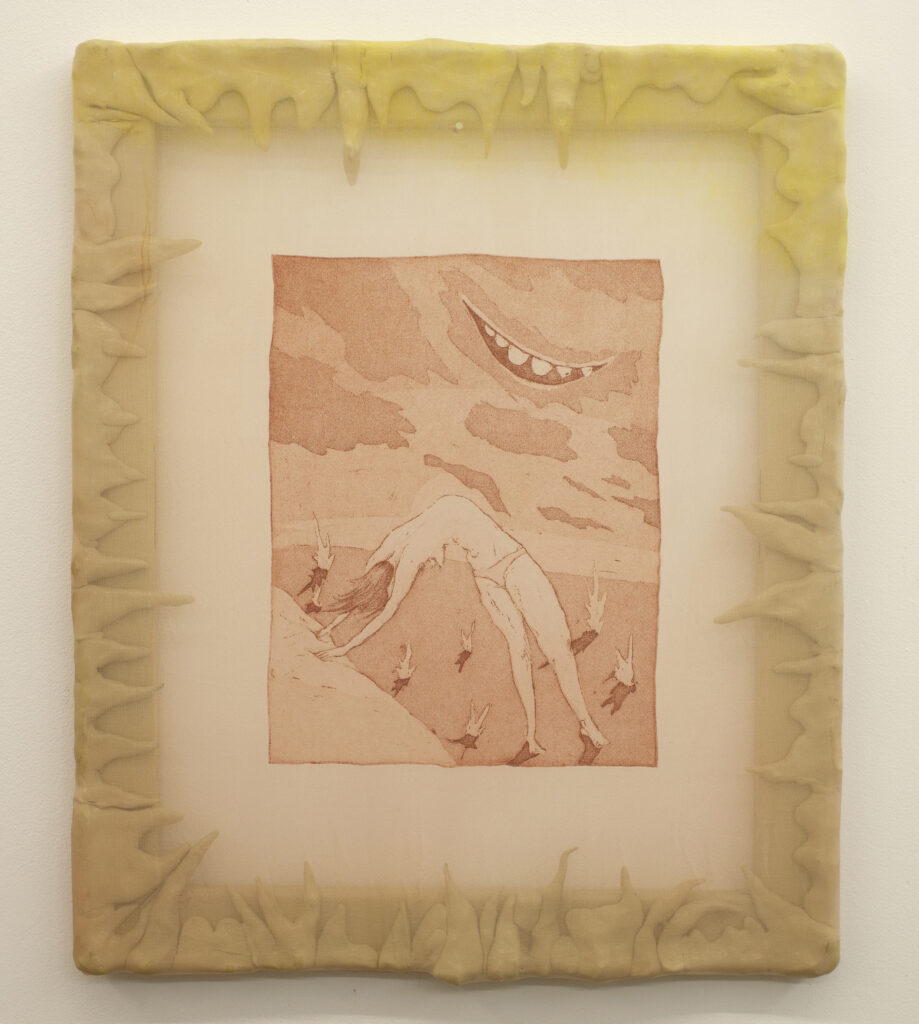
Please do, I’ll be there with champagne! What are your plans for the next series, staying with one pigment?
I want to do something else. I will still do natural pigments, but I’m thinking of including some clay works. I usually work in series, so the stone made sense for that project. A lot of people ask me how long my career is going to last once the stone is finished! I don’t want people to think I only paint with stones, because that’s not the point. I use it to communicate a story, and I don’t believe in the idea of sustainability where people would think that not using plastic or not using oil paint is what will save us. It is more nuanced than that, and I am dealing with contradictions on a daily basis. The beginning of a new project is always hard, so I try just to start working and see where it goes. I will continue in earthly tones though; maybe one day I’ll gradually get to blue!
Final question: if you could show your work anywhere, limitless budget, what your dream project would be
Let me see. I am thinking about both Brazil and the UK as it is where I would like to have conversations, and I love so many galleries in both places. I’m going to go ahead and say Bienal de São Paulo and the Venice Biennale! Those are dreams! And maybe a tiny painting in the Marianne North Gallery, at the Kew Gardens, maybe of a very weird sci-fi plant, placed amongst her thousands of paintings. As if she painted the past, and I painted the future.
Well, I look forward to the private view!
Yes, me too !

This interview took place on 15/09/21 and Paula has since handed in her thesis!
You can see more from Paula on her website and on her Instagram, @paula.turmina.
You can see the works from Paula’s graduate show here.
Featured Image: Paula Turmina, Hot House from series Sun Worshippers (2021). Oil on canvas. 140×110 cm.





